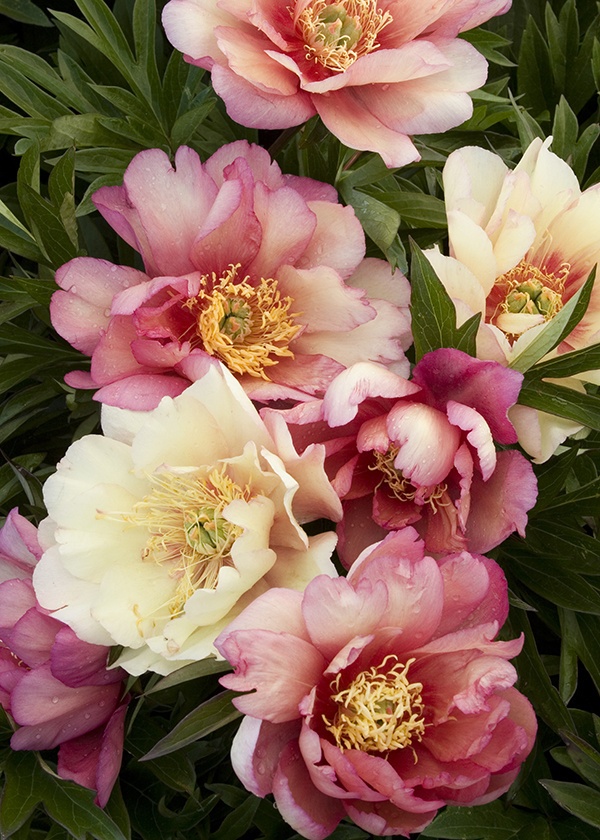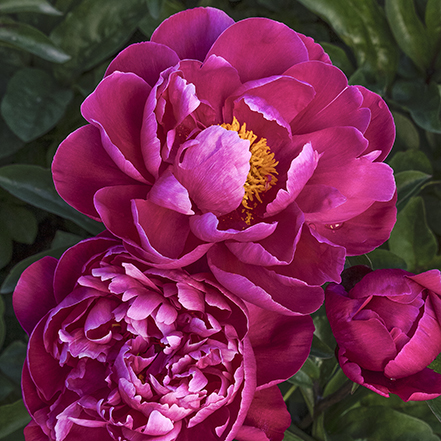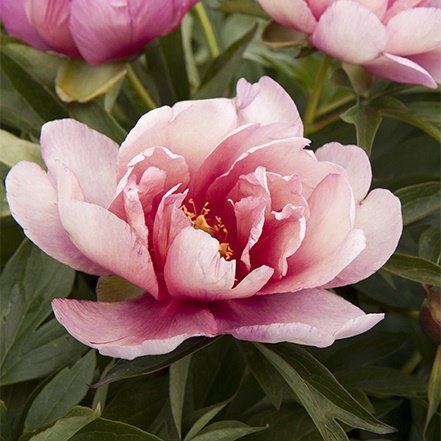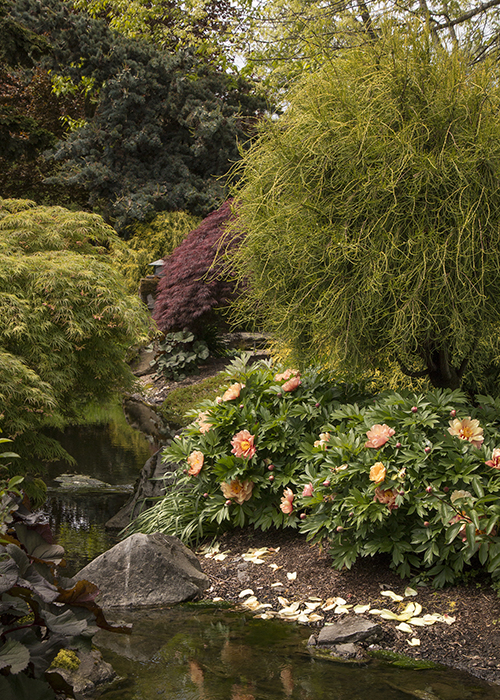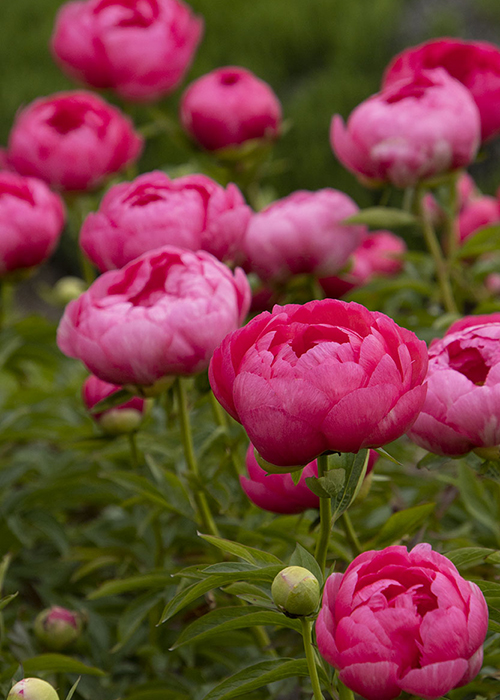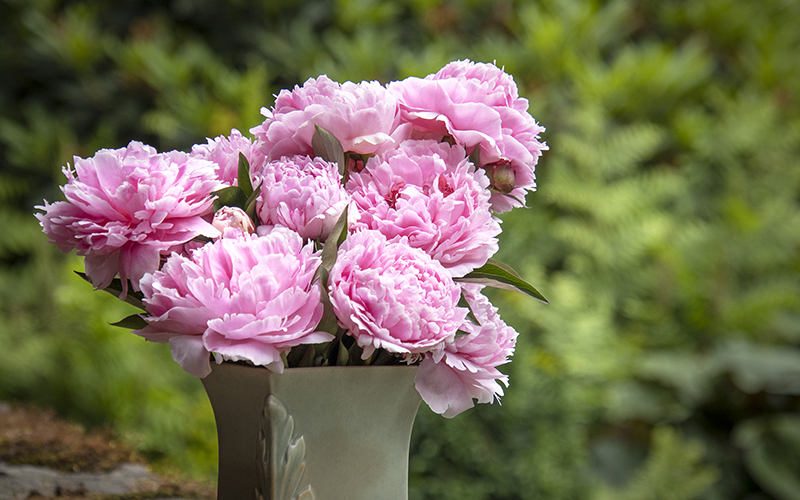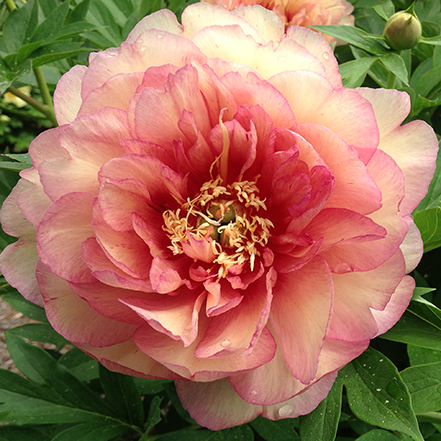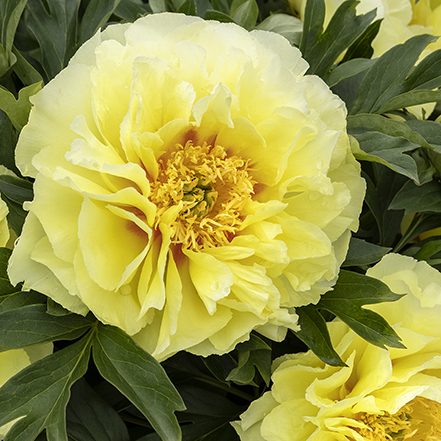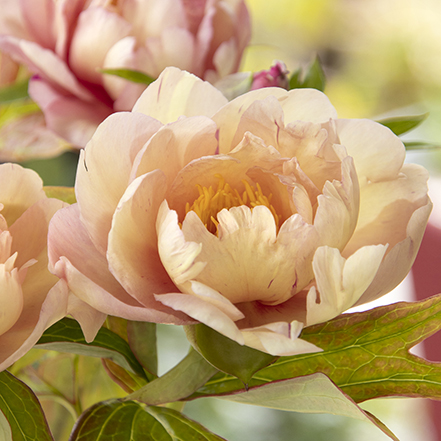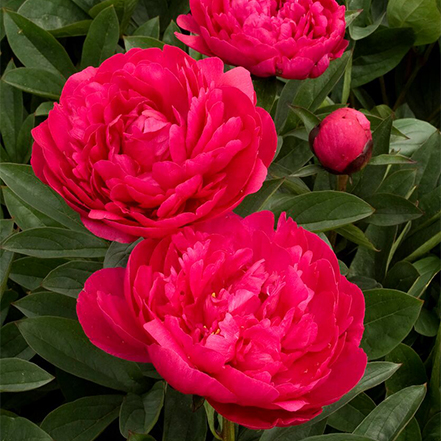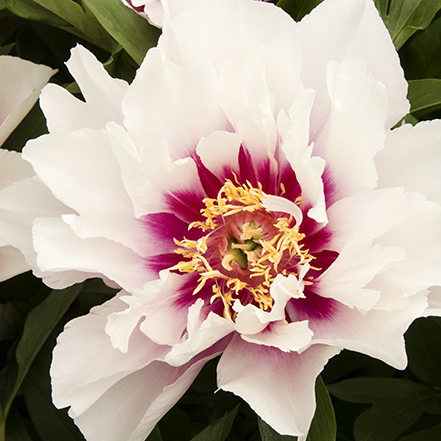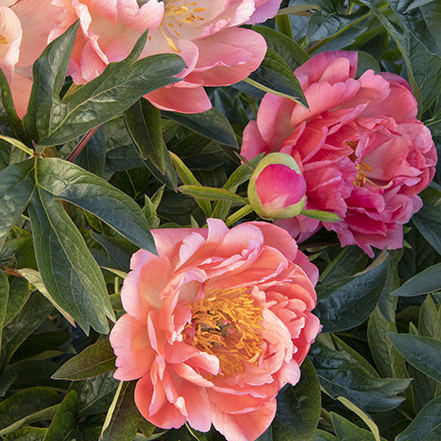With big, subtly fragrant blooms and a range of striking colors, it's no secret why peonies are a beloved staple in gardens across America. Whether you enjoy the vibrancy of a deep-fuchsia peony or the romantic charm of a coral variety, these big perennials have something to offer in your outdoor space. Plus, did you know that with the proper care, peony plants can bloom for 100 years or more?
The first step in adding this garden staple to your space is choosing the right variety. Then, you'll need to be sure to plant in the appropriate conditions and practice regular care to acclimate your peonies properly. Our peony care guide is here to help you do just that. Let's dive in.
(Above) Julia Rose Itoh Peony have sturdy stems that support stunning, sizable double flowers that rise above lush, foliage, eliminating the need for staking. The pleasantly fragrant blooms have soft apricot petals accented by reddish-purple tips and vibrant yellow centers. The stunning cut flowers make a delightful addition to any spring bouquet. Part to full sun. Up to 3' tall and wide. Zones 4-9.
Types of Peonies
Red Sarah Bernhardt Peony (Paeonia lactiflora) is an herbacious peony.
Keiko™ (Adored) Itoh Peony is an intersectional hybrid peony.
Peonies are beloved for their easy-going nature and beautiful, large blossoms that burst into color in late spring and early summer. They belong to the Paeonia genus, which has species that are native to Asia, Europe, and Western North America. Peonies come in tons of colors to match different spaces, and some have a subtle (but delightful) fragrance.
Peonies can be categorized into three primary types:
- Herbaceous Peonies: Herbaceous peonies are cold-hardy and grow on long stems. They require a cold season to bloom, so are not often grown in warmer climates. Regarded as the most common kind of peony, herbaceous peonies die back to the ground during late fall and rebloom come springtime. Herbaceous peonies are chiefly from the Chinese species P. lactiflora.
- Tree Peonies: Tree peonies are stemmed shrubs that bloom earlier than herbaceous peonies and can grow up to 6 feet tall. This peony variety has larger flowers, too. Tree peonies form woody trunks and have the species names Paeonia suffruticosa or P. suffruticosa x P. lutea or P. delavayi.
- Intersectional Peonies: This is a hybrid type created by crossing herbaceous and tree peonies, and includes the stand-out Itoh Peony. Intersectional peonies possess attributes of both herbaceous and tree peonies, like the large flowers of tree peonies and the ability to die back to the ground in winter like herbaceous peonies. However, Itoh Peonies do not require a winter chill, which makes them ideal for warmer climates. These intersectional varieties can provide up to 6 weeks of color as new buds open to replace faded blooms.
Ideal Conditions for Growing Peonies
(Above) Misaka™ Itoh Peony paired with Weeping Threadleaf Arorvitae in the landscape, planted far enough away from the water to ensure well-drained soil.
Although peony plants are known for their easy care, remember that they can live for decades and should be considered a permanent part of your landscape. You want to find the perfect spot for this plant to get comfortable — it'll likely be there for a while!
Ideal conditions for peonies include:
Full Sun
Peonies prefer full sun, at least 6 hours a day, so make sure you choose a sunny and well-drained spot for this plant. Peonies in the warmest end of their range (Zone 8) need afternoon shade, so check the specifics of your variety before planting. Without the proper sunlight, your peony might produce fewer blooms, which means less color in your garden.
Well-Drained Soil
Use soil that's fertile and well-drained, as peonies need lots of nutrients but won't appreciate a soggy, clay-like environment. Don't plant your peony too close to competing roots of other shrubs and trees, and make sure the soil has a slightly acidic or neutral pH. Tree peonies prefer more alkaline soil.
Most importantly, never plant your peonies in a wet or soggy area. If you don't have ideal soil, consider planting in a raised bed where your peony plant will get the right drainage.
Regular Water
Your peony will need to be watered deeply every 7-10 days to help it become established with a deep root system. Once established, peonies are drought-resistant. As a general rule, the first two inches of your mature peony's soil should be dry. Don't overwater!
Temperature and Climate
Peonies love their sunlight, and their foliage needs to bask in the hot sun in the summer to reserve energy for fall and winter. Herbaceous peonies need a period of cold winter temperatures to form their buds for the spring, so a climate that provides hot summers and cold winters is ideal.
Itoh peonies, however, do not require winter chill, so they are ideal for growing in a warmer climate.
Space
To support peonies’ large, heavy flowers, a strong root system is absolutely necessary. This can be established by making sure the plants have sufficient space to grow. If planting multiple peonies, maintain at least 3-4 feet distance between each. Give each plant some room to breathe!
A Guide for Planting Peonies
(Above) Cytherea Peonies have intense coral-rose semi-double flowers that soften in color as they age, creating a bouquet of colors ranging from deep rose to pale peach-pink. The sturdy, upright stems make them ideal for cut flowers.
With the ideal conditions in place, it's time to review planting your peonies. Whether you're adding a pop of color along a walkway or a central display of blooms to your garden layout, here's what you need to know.
When to Plant Peonies
Peonies can be planted in the spring or fall in most of the United States. Depending on your zone, you may need to plant them even later in the fall. Find your planting zone here.
If planting in the fall, peonies should be settled into place about six weeks before the ground freezes. Peonies that are planted in the spring generally lag about a year behind those planted in the fall.
How to Plant Peonies
- First, choose a peony that will bloom in its first year. Monrovia peonies, for instance, are already two years old and ready to bloom prolifically by the time they make it to the garden center. Many other peonies at the garden center will be much younger, and may take up to two years before they start to bloom.
- If planting multiple, space your peonies 3 or 4 feet apart so their roots can grow and spread. This also helps with air circulation between plants to avoid humidity build-up.
- Next, dig a hole that's twice as wide as the peony's root ball but no deeper. If the soil is heavy or extra sandy, add a shovelful of compost to the bottom of the hole.
- Now, set the root so the "eyes" (growth nodes) of the peony face upward on top of a mound of soil in the hole. Place the roots just 2 inches below the soil surface. Remember not to plant too deep; if the peony root is positioned deeper than 2 inches, it may grow well, but it won't produce many blooms.
- Once the peony is set, backfill the hole, and don't cover your peony any deeper than it grew in its pot. Water it deeply and mulch.
Initial Care After Planting
The initial care following planting is important to establish the peony flowers. Keep the soil around the newly planted peonies moist, but avoid overwatering to prevent root rot, a common problem for peonies. A layer of mulch can help conserve moisture and keep weeds at bay.
Fertilization right after planting is typically not needed, as the organic matter previously mixed into the soil should provide plenty of nutrients for the initial growth.
If you didn't bring home a Monrovia peony (which is older and therefore ready to bloom), your peonies may not bloom during their first year after planting. Don't panic! This can be normal for young peonies, especially if grown from bare root.
Tips for Nurturing and Maintaining Your Peonies
(Above) Sarah Bernhardt Double Peonies are stunning cut flowers and gorgeous in beds and borders.
We've said that peonies are beloved for their low-maintenance nature, but what does that mean in terms of regular care? While these plants prefer benign neglect, you have to know when to step in and give them a little nudge. Here are some tips for maintaining peonies:
- Spare the fertilizer. If you work your soil well when planting and add some compost, this should be enough for your plant. If your soil is especially poor, apply fertilizer early in the summer once your plant has bloomed. Don't fertilize more than every few years.
- Don't overwater. Peonies don't like soggy soil. In a sweltering, dry summer, water your peonies every week or so. You can always test the soil with your fingers to feel how dry it is. In regular conditions, you only need to water your peonies every 1-2 weeks.
- Plant varieties with stronger stems. Because peonies can have huge blossoms, it's common for older varieties to need a little extra support to do the heavy lifting. Monrovia-grown peonies tend to have extra-sturdy stems and need little, if any support. If you notice your peony stems seem weak, try using three-legged peony rings or wire tomato cages for support.
Fall and Winter Peony Care
Peonies need a cold season to prepare their buds, but before they go into the winter, here are some care tips:
- After frost, you'll notice the peony foliage dies back completely. Cut your plant to the ground in the fall to avoid overwintering diseases.
- Don't smother your peony plants with mulch. If you live in a region where cold temperatures are severe, for your first winter after planting, you can mulch loosely with shredded bark, but this isn't necessary for mature plants. If you do apply a light layer of bark, remove the mulch in the spring.
When and How to Prune Peonies
Pruning is part of regular maintenance for peonies and should be done in the fall once the peony leaves turn yellow. Never cut back your peonies in the summer, even after the blooms are gone. Peony foliage needs to bask in the sun until fall to soak up the rays and convert that energy into food reserves.
Once your peony leaves turn yellow, it's time to trim. Cutting away dead foliage on your peony helps ward off insects and diseases. Plus, if the foliage is dense, thinning it out helps increase airflow and the amount of sunlight the peony gets.
To prune, cut the peony stems back at or near ground level (don't damage the crown). While you want to give the plant some space, it doesn't need a lot of pruning. If you have a tree peony, follow the same steps, but don't remove the woody part of the plant.
More Peony Pruning Tips:
- Remove any damaged or diseased plant material immediately.
- Clean your pruning shears before and after to prevent the spread of diseases.
Other Common Peony Care Questions
When is the best time to move peony plants?
If you need to move your peony plant, the best time to do it is in the fall. Remove its leaves and dig around the peony's roots in a large circle, then lift up your plant. Prepare its new location beforehand for quick planting.
How do I treat powdery mildew on peonies?
If you've noticed powdery mildew (white residue on foliage), you'll need to treat the plant with an organic fungicide or horticultural oil. Spray the solution on your peony every 10-14 days during cool weather.
To prevent powdery mildew, make sure you plant your peonies in full sun and avoid watering from overhead and getting water on the leaves. If you have an irrigation system that gets your peony's leaves wet, make sure to set it to water in the morning so the leaves can dry in the sun during the day. High temperatures and sunlight help ward off this problem, as well.
If mildew is a problem in your garden, look for peonies with mildew resistance.
Why hasn't my peony produced buds?
There are a lot of reasons why a peony may not flower. First, if your peony was just planted, expect it to take a year to bloom. If you recently transplanted it, it could take up to 3 years to flower in full, so try to be patient!
Also, take note of any changing conditions that may have affected your peony. Is there a growing tree blocking its sunlight? Was the winter not cold enough to let it form buds? Double-check that there isn't mulch build-up, too, that could've buried your peony's roots.
There are ants on my peony buds! Will they hurt it?
No, ants are harmless, and a common peony visitor. Peonies have nectaries which secrete a sweet nectar on the outside of the buds. Ants love this delicious treat, so you might see them crawling on your buds. They won't do any harm to the plants. If you cut your peonies for arrangements, just turn them upside down and give them a shake so you don't bring some hitchhikers into your house.
When should I cut my peonies for floral arrangements?
Peonies can be cut for arrangements at the "marshmallow stage" or later. This is when the flower is still in the shape of a bud, but the petals have fully colored and it is soft and squishy like a marshmallow. Buds that are cut when they are still tight and hard will not open in a vase. Don't cut the stems all the way to the ground; try to keep some leaves on the stem to help the plant store energy for next year.
The Beauty of Peonies
With vibrant blooms and fresh-cut fragrances, peonies make a great addition to a variety of spaces and growing zones. From the soft appeal of a Bartzella Itoh Peony to the striking surprise of the Cora Louise Itoh variety, gardeners can find endless uses and design inspiration in these tried-and-true plants. Explore our peony offerings today to find your next landscape staple.
More of Our Favorite Peonies
Garden Candy™ Truly
Scrumptious Itoh Peony
Petals transition from peachy orange to creamy white and gently fade to pink along the edges. With flowers held closer to the foliage, the plant forms a compact, rounded shape that doesn't need staking. The mildew-resistant foliage remains attractive throughout the entire season. Partial to full sun. Up to 3' tall and wide. Zones 4-9.
Bartzella
Itoh Peony
Very large, bright yellow double blossoms with a slight red center stain stand above the lush, dark green, deeply dissected foliage. Flowers have a pleasant, slightly spicy scent. An especially vigorous plant with sturdy flower stems that do not require staking. Part to full sun. Up to 3' tall and wide. Zones 4-9.
Singing in the
Rain Itoh Peony
A rare, yet hardy hybrid with creamy yellow, semi-double blooms that become flushed with salmon coloring as they mature. The flowers have a soft, pleasing scent, and are perfect for cutting. Forms a lush mound of foliage with an abundance of blooms every spring. Partial to full sun. Up to 3' tall, 4' wide. Zones 4-8.
Kansas
Double Peony
Huge, double, carmine red blooms are displayed on the bold, erect stems of this clumping perennial, and make for beautiful cut flowers. An excellent background plant for spring bulbs, or use in perennial or shrub borders. American Peony Society award winner. Zones 4-8.
Cora Louise
Itoh Peony
Large, semi-double, lightly fragrant blossoms are white with striking dark lavender central flares, and stand above lush, toothed foliage. An especially vigorous plant - producing up to 50 blooms in a single season. Sturdy flower stems require no staking. Part to full sun. Up to 3' tall and wide. Zones 4-8.
Coral Charm
Peony
Abundant, large, cup-shaped flowers emerge as a deep persimmon color and bloom out to elegant, coral-cream-colored, semi-double flowers with a slight fragrance as they mature. Part to full sun. Up to 3' tall and wide. Zones 4-8.
Get More Plant Care Tips and Guides
- Sign up for the Grow Beautifully Newsletter. You'll get gardening tips, design advice, free digital guides, and live webinar invites. Plus, new, exclusive plant information delivered straight to your inbox twice a month.
- Hibiscus Care Guide
- Conifer Care Guide
- Boxwood Winter Care
- Azalea Care Guide
- Hydrangea Care Guide
- Top 10 Tips for Planting in Summer
- How to put Hydrangeas to Bed for Winter
- Our Top 10 Gardening Tips
- Guide to Pruning Flowering Shrubs
- How and When to Prune Hydrangeas
- Pruning Ornamental Grasses
- How and When to Prune Lavender
- Check out the "Garden Tips" section of the blog. Here there are care guides and garden tips on a wide array of plants.





